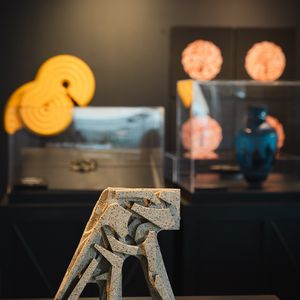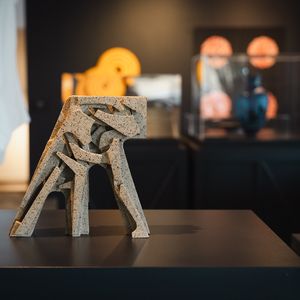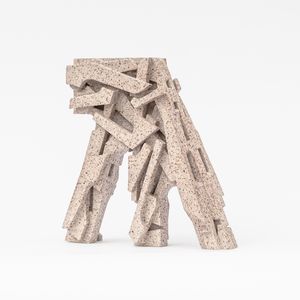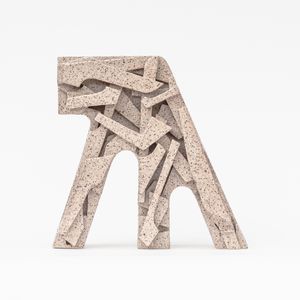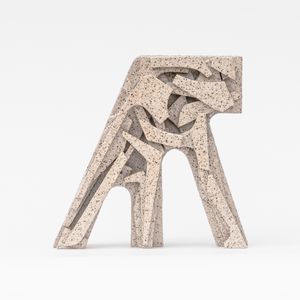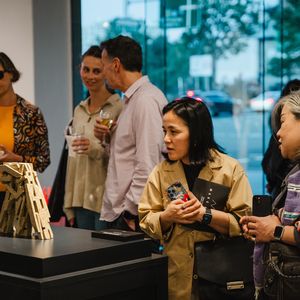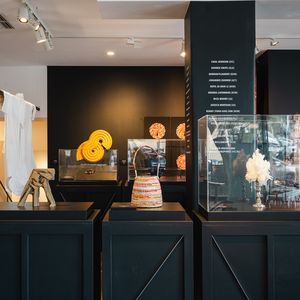Object Podcast Series 3 Episode 4: Csongvay Blackwood
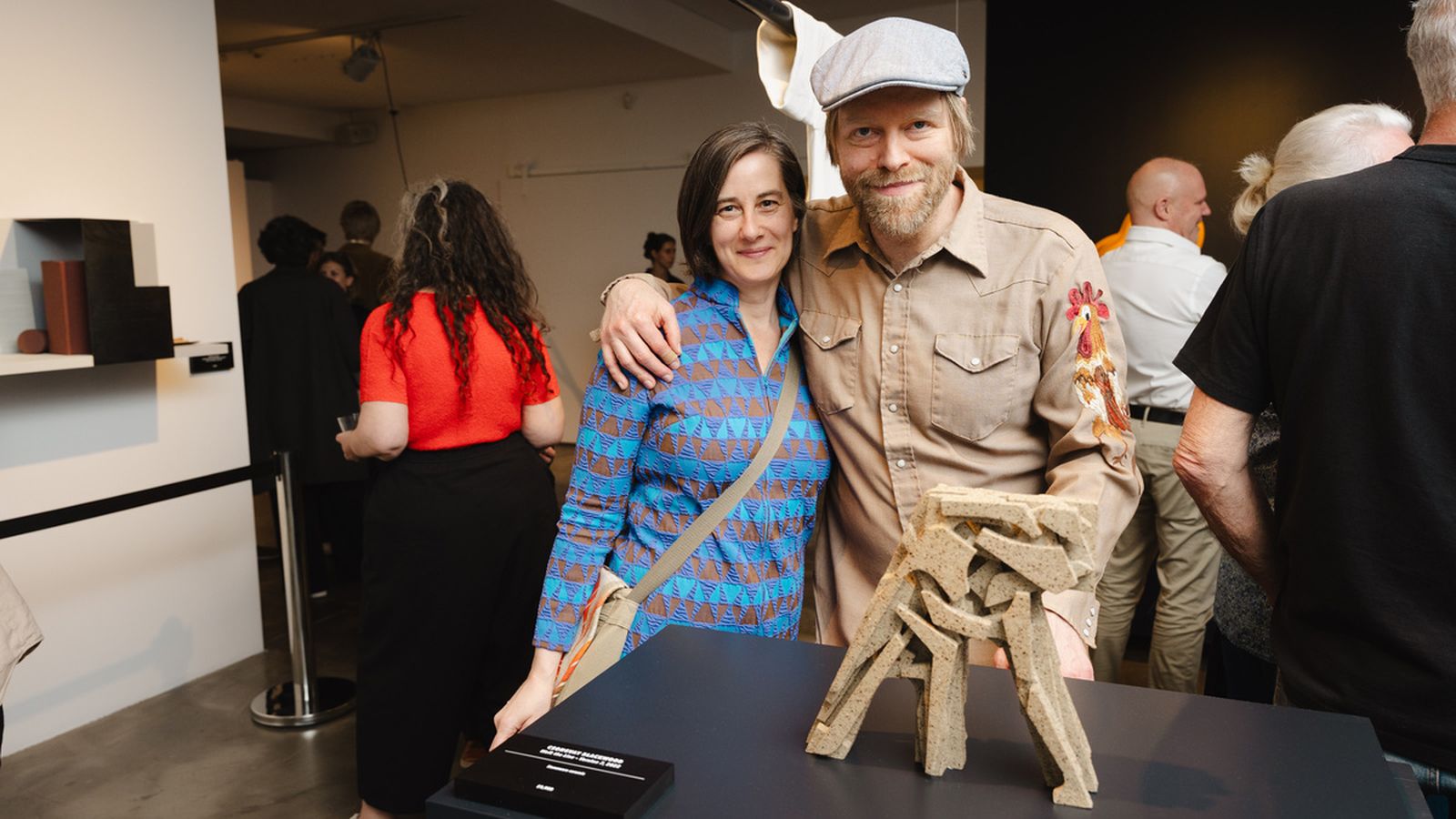
Series 3: Behind the scenes of MAKE Award: Biennial Prize for Innovation in Australian Craft and Design
Episode 4: Csongvay Blackwood, Finalists in 2023 MAKE Award.
Show notes
Host Lisa Cahill chats with partners in life and work, Csilla Csongvay and Matt Blackwood. In this episode, Csilla and Matt share the inspirations behind their work, what it takes to enter an award, and how they made a single sculpture from 100 pieces of clay.
Hear from judges Jason Smith, Hyeyoung Cho and Brian Parkes on their work, Walk the Line Version 7.
Working as Csongvay Blackwood, Csilla and Matt design and create their ceramic artworks by hand: initially by drawing dozens of designs, and then using various slab-building methods to create a series of prototypes, which are further refined in order to achieve the desired geometries. Most pieces are made over several weeks, and some pieces require months to dry.
All artworks are designed and made in Csongvay Blackwood’s studio in Melbourne, Australia.
Transcripts
Word document: TRANSCRIPT OBJECT Podcast S3 Ep 4 Csongvay Blackwood
PDF document: TRANSCRIPT OBJECT Podcast S3 E4 Csongvay Blackwood
Guests
- Csilla Csongvay, artist
- Matt Blackwood, artist
- Jason Smith, Director and CEO of Geelong Gallery, Victoria
- Hyeyoung CHO, Chair of the Korea Association of Art and Design, and expert panel member of the Loewe Foundation Craft Prize
- Brian Parkes, CEO at Jam Factory, Adelaide, South Australia
Show highlights and takeaways
Varied background [1:40]
Csilla Csongvay and Matt Blackwood make sculptural work, in ceramics. Their previous work includes film and TV, and public art.
First reveal [2:10]
Csilla says that they had been working on their MAKE Award entry, Walk the Line Version 7, for a ‘very long time’, and that entering the award was the first time they’d made the piece public.
“We didn't distribute any work in progress videos or any images. This MAKE Award was the first time when we sent out images of Walk the Line Version 7. And to be shortlisted as finalists for the award was incredible. It showed to us that our dedication to what we do and our dedication to this piece had been recognised and celebrated by our peers. We were thrilled.”
Walk the Line version 7 [3:00]
Their award entry is a stoneware ceramic sculpture, approximately 28 cm high, 28 cm long and about 7 cm deep. The form is geometric and it’s made of approximately 100 individually cut ceramic pieces.
Csongvay Blackwood use iron-rich, groggy clay, which is fired to high stoneware temperature without glazing, resulting in a textured, speckled finish.
Hyeyoung Cho, MAKE Award Judge [5:15]
Hyeyoung Cho appreciates the work for breaking away from the norm and introducing innovative concepts. She notes the constructive and sculptural use of layers in the piece, and the new shape it presents.
Construction process [5:45]
Walk the Line Version 7 is made from about 100 unique ceramic pieces. Csilla starts by working from the middle of the piece out. She then builds the sculpture layer by layer, constantly evaluating the movement and balance between void and fill.
“I'd be looking at where the clay joins, what shape is formed.”
Flexibility of clay [8:03]
Csilla describes the advantage of working with clay by highlighting the flexibility it offers during the construction process. She emphasises that, unlike more rigid materials, clay allows her to move and adjust individual pieces before permanently joining them.
The process involves scoring and scratching the clay pieces, wetting them down with more clay, and then joining them together. This flexibility means Csilla can experiment with the arrangement of pieces, ensuring that she is satisfied with the flow of energy, the balance between void and fill, and the overall composition of the sculpture before making the final connections.
Jason Smith, MAKE Award Judge [8:40]
Jason Smith, CEO and Director of the Geelong Gallery, appreciates Csongvay Blackwood’s unique and experimental approach to ceramics. He notes that the sculpture stands out as a distinctive and unique ceramic object, showcasing a form not commonly seen in ceramics practice.
A distinct series
Matt says they designed this series as quite distinct from everything else that they’ve designed previously for the past ten years. Previously Matt would create a design and Csilla would replicate it.
“Then it came to a point,” Matt says, “even with a design that was particularly successful, that Csilla came up to me and said ‘If I have to make another one of those, I'm going to scream.’”
A visual alphabet
Instead of making the same design over and over, they said, “Let's design a series.”
“This is what Walk the Line is - a series that can have a standard set of forms. There's actually 27 forms in the series, essentially meant to be a visual alphabet.”
“I wanted to create the standard 27 forms that could actually be built internally in an infinite amount of ways. Each piece that Csilla makes... because it's made up of those one hundred or so pieces, they're never put together the same way.”
‘We adore movement’
Matt says they want it to seem almost like each layer of the sculpture is going in different directions, capturing the essence of movement frozen in a single moment. This approach reflects their background in filmmaking, where they visualise the individual layers as frames in a moving sequence.
What Csongvay Blackwood hope the judges see in their work [8:40]
Csilla and Matt hope the judges acknowledge the level of commitment, dedication, and love they have invested in working with clay. They want their work to highlight the diversity of ceramics as an artistic medium.
Csilla and Matt emphasise that clay, while challenging to work with, offers many possibilities, and they hope their pieces inspire others to explore and push the boundaries of what can be achieved with clay.
Brian Parkes, MAKE Award Judge [11:30]
As an ardent fan of modernism, Brian finds their hand-building approach distinctive. He particularly admires the typographic formalism and the incorporation of symbols within symbols in their work.
“It's lovely to see a hand building practice take such prominence and such a distinctiveness in a time when ceramics is in the great ascendancy.”
What artists consider when entering an award
Matt says one of the things that a lot of artists have to consider is, ‘If we do submit our piece to an award, How much is it going to cost for us to get it up there? And what is the return?’
“Unfortunately it is a transactional experience quite often, but the reality is the returns.”
The MAKE Award’s touring exhibition [17:00]
Matt explains that the MAKE award’s touring exhibition of finalists makes a huge difference.
“It is just such a rare opportunity to actually have our pieces be exhibited, not only in three different places, but three places of really high standing.”
MAKE Award a ‘champion of design’
Matt appreciates that the MAKE Award specifically focuses on design.
“There aren't enough people raising the banner, raising the flag for design and actually saying, This is a really considered process.’”
CREDITS
Object is a podcast of the Australian Design Centre. Object is produced by Jane Curtis, in collaboration with Lisa Cahill. Sound engineering is by John Jacobs.
Return to Object: stories of design and craft main page

